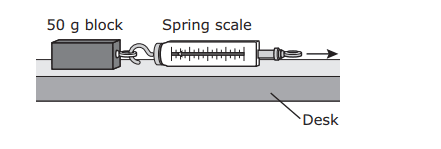
5.6.D Design An Experiment That Tests The Effect Of Force On An Object
Quiz by Grade 5 Science - Texas Education Agency
Grade 5
Science (2010) (Archived)
Texas Essential Knowledge and Skills (TEKS)
Feel free to use or edit a copy
includes Teacher and Student dashboards
Measures 1 skill from
Measures 1 skill from
Track each student's skills and progress in your Mastery dashboards
With a free account, teachers can
- edit the questions
- save a copy for later
- start a class game
- automatically assign follow-up activities based on students’ scores
- assign as homework
- share a link with colleagues
- print as a bubble sheet
6 questions
Show answers
- Q1A student uses a spring scale to pull a 50-gram block horizontally across a wood desk. Then the student pulls the block the same distance across surfaces of carpet, sandpaper, and glass. Which question is this investigation most likely designed to answer?How do blocks affect spring scales?How does the mass of a block change when it is pulled across a desk?How do different surfaces affect the amount of force needed to move a block?How do blocks of different sizes react to force?60s5.6.D: Force, Motion and Energy
- Q2A student observes that the craters on the moon are different sizes. The student designs an experiment to study the formation of craters. The materials for the experiment are marbles and a pan of flour. The student makes a hypothesis that the size of the craters made on the surface of the flour will depend on the height from which the marble is dropped. Some of the steps in the student’s experiment are described below. Which of these is most likely Step 3 in the student’s experiment?Drop the same marble from different heights into the pan of flourDrop marbles of different masses from the same height into the pan of flourDrop a single marble one time into the pan of flourDrop marbles of different sizes from different heights into the pan of flour60s5.6.D: Force, Motion and Energy
- Q3A student designs an experiment to test the force of a spring using a spring launcher and four spheres with the same diameter but with different masses. What other piece of equipment would be most useful for this experiment?A stopwatch to measure how long it takes to load each sphere on the springA graduated cylinder to measure the volume of each sphere before the sphere is launchedA beaker to collect the spheres after they are launchedA meterstick to measure the height each sphere reaches after the sphere is launched60s5.6.D: Force, Motion and Energy
- Q4A student designs an experiment to test the effect of the width of a piece of elastic on the elastic’s ability to stretch. The student selects four pieces of elastic with different widths but the same length. The student then attaches blocks with different masses to the pieces of elastic. The results of the student’s experiment are shown below. What should the student do to improve this experiment?Use more than four pieces of elastic and four blocksUse blocks of equal mass on the four pieces of elasticUse blocks with enough mass to cause the four pieces of elastic to breakUse four pieces of elastic with different lengths but the same width60s5.6.D: Force, Motion and Energy
- Q5Students drop the same heavy ball onto identical blocks of soft clay from different heights. For each height they measure the depth of the dent the ball makes in the clay. Why is the depth of the dent different in each trial?The force of the ball when it hits the clay changes.The mass of the ball when it hits the clay changes.The material of the ball changes.The size of the ball changes.60s5.6.D: Force, Motion and Energy
- Q6The diagrams show two trials of an experiment in which a spring scale was used to measure force. This experiment can be used to determine —how the mass of a box of marbles affects the mass of a dictionaryhow the force used to pull a dictionary affects the mass of a box of marbleshow mass affects the force needed to move objectshow force affects the mass of two objects60s5.6.D: Force, Motion and Energy
